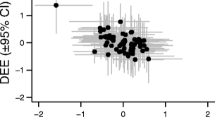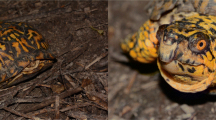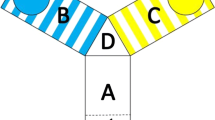Abstract
Stable differences in physiology among individuals may facilitate the evolution of consistent individual differences in behavior. In particular, according to the pace-of-life syndrome (POLS) hypothesis, individual variation in metabolic expenditure and stress physiology should be linked with exploration, aggression, or risk-taking behaviors. Previous studies have uncovered stable individual differences in metabolic expenditure and circulating glucorticoids in common lizards (Zootoca vivipara). We tested the correlations between standard metabolic rates (SMR), glucorticoid stress response, and behavioral traits (activity, aggressiveness, risk taking, and sociability) in males. In ectotherms, the thermal dependence of SMR should be included in the POLS hypothesis; we therefore measured SMR at three temperatures from rest to preferred body temperature. Activity, aggressiveness, and risk taking, but not sociability, exhibited significant, short-term repeatability, and little correlation was found between behavioral traits. The SMR of lizards with a low metabolism at rest increased faster with body temperature. The SMR at rest was negatively correlated with behavioral variation in sociability and activity but not with risk-taking behavior. In addition, the plasma corticosterone level after an acute handling stress increased slightly but not significantly with aggressiveness. We discuss alternative interpretations for these relationships and conclude that the link between inter-individual variation in physiology and behavior is trait-dependent in the common lizard.
Significance statement
Selection better promotes the evolution of consistent differences in behavior, or personalities, when they are coupled with differences in physiology. In adult common lizards, inter-individual differences in metabolic expenditure and glucocorticoid stress response are consistent and could play a crucial role in the maintenance of personalities. This study supported partially this hypothesis. We found that more sociable and active personality types had a lower metabolic expenditure, while more aggressive personality types tended to have a higher physiological stress response. At the same time, physiology was not correlated with individual differences in risk-taking behavior and drove little part of behavioral variation. The coupling between personalities and physiology appears to be trait-dependent, suggesting that behaviors may be relatively free to evolve independently from physiology.


Similar content being viewed by others
References
Andrews RM, Pough FH (1985) Metabolism of squamate reptiles—allometric and ecological relationships. Physiol Zool 58:214–231
Artacho P, Nespolo RF (2009) Natural selection reduces energy metabolism in the garden snail, Helix aspersa (Cornu aspersum). Evolution 63:1044–1050
Artacho P, Jouanneau I, Le Galliard J-F (2013) Interindividual variation in thermal sensitivity of maximal sprint speed, thermal behavior, and resting metabolic rate in a lizard. Physiol Biochem Zool 86:458–469
Artacho P, Saravia J, Ferrandière BD, Perret S, Le Galliard J-F (2015) Quantification of correlational selection on thermal physiology, thermoregulatory behavior, and energy metabolism in lizards. Ecol Evol 5:3600–3609
Baugh AT, Schaper SV, Hau M, Cockrem JF, de Goede P, van Oers K (2012) Corticosterone responses differ between lines of great tits (Parus major) selected for divergent personalities. Gen Comp Endocrinol 175:488–494
Baugh AT, van Oers K, Naguib M, Hau M (2013) Initial reactivity and magnitude of the acute stress response associated with personality in wild great tits (Parus major). Gen Comp Endocrinol 189:96–104
Bell AM, Hankison SJ, Laskowski KL (2009) The repeatability of behaviour: a meta-analysis. Anim Behav 77:771–783
Biro PA, Stamps JA (2010) Do consistent individual differences in metabolic rate promote consistent individual differences in behavior? Trends Ecol Evol 25:653–659
Burnham KP, Anderson DR (1998) Model selection and inference: a practical information-theoretical approach. Springer Verlag, New York
Careau V, Garland TJ (2012) Performance, personality and energetics: correlation, causation and mechanism? Physiol Biochem Zool 85:543–571
Careau V, Thomas D, Humphries MM, Réale D (2008) Energy metabolism and animal personality. Oikos 117:641–653
Careau V, Bininda-Emonds ORP, Thomas DW, Réale D, Humphries MM (2009) Exploration strategies map along fast–slow metabolic and life-history continua in muroid rodents. Funct Ecol 23:150–156
Careau V, Gifford ME, Biro PA (2014) Individual (co)variation in thermal reaction norms of standard and maximal metabolic rates in wild-caught slimy salamanders. Funct Ecol 28:1175–1186
Carere C, Groothuis TGG, Möstl E, Daan S, Koolhaas JM (2003) Fecal corticosteroids in a territorial bird selected for different personalities: daily rhythm and the response to social stress. Horm Behav 43:540–548
Chessel D, Dufour A-B, Thioulouse J (2004) The ade4 package—I—one-table methods. R News 4:5–10
Cockrem J (2007) Stress, corticosterone responses and avian personalities. J Ornithol 148:169–178
Coppens CM, de Boer SF, Koolhaas JM (2010) Coping styles and behavioural flexibility: towards underlying mechanisms. Philos T Roy Soc B 365:4021–4028
Cote J, Clobert J (2007) Social personalities influence natal dispersal in a lizard. Proc R Soc Lond B 274:383–390
Cote J, Clobert J, Meylan S, Fitze PS (2006) Experimental enhancement of corticosterone levels positively affects subsequent male survival. Horm Behav 49:320–327
Cote J, Dreiss A, Clobert J (2008) Social personality trait and fitness. Proc R Soc Lond B 275:2851–2858
Cutts CJ, Adams CE, Campbell A (2001) Stability of physiological and behavioural determinants of performance in Arctic char (Salvelinus alpinus). Can J Fish Aquat Sci 58:961–968
Dauphin-Villemant C, Xavier F (1987) Nycthemeral variations of plasma corticosteroids in captive female Lacerta vivipara Jacquin: influence of stress and reproductive state. Gen Comp Endocrinol 67:292–302
de Fraipont M, Clobert J, John-Alder H, Meylan S (2000) Increased pre-natal maternal corticosterone promotes philopatry of offspring in common lizards Lacerta vivipara. J Anim Ecol 69:404–413
Dingemanse NJ, Wolf M (2010) Recent models for adaptive personality differences: a review. Philos T Roy Soc B 365:3947–3958
Fitze PS, Cote J, San-Jose LM, Meylan S, Isaksson C, Andersson S, Rossi J-M, Clobert J (2009) Carotenoid-based colours reflect the stress response in the common lizard. PLoS ONE 4:e5111
Garamszegi LZ, Gábor M, Herczeg G (2012) A meta-analysis of correlated behaviours with implications for behavioural syndromes: mean effect size, publication bias, phylogenetic effects and the role of mediator variables. Evol Ecol 26:1213–1235
Groothuis TGG, Carere C (2005) Avian personalities: characterization and epigenesis. Neurosci Biobehav R 29:137–150
Koolhaas JM, Korte SM, de Boer SF, van der Vegt BJ, van Reenen CG, Hopster H, de Jong IC, Ruis MAW, Blokhuis HJ (1999) Coping styles in animals: current status in behavior and stress physiology. Neurosci Biobehav R 23:925–935
Koolhaas JM, de Boer SF, Coppens CM, Buwalda B (2010) Neuroendocrinology of coping styles: towards understanding the biology of individual variation. Front Neuroendocrin 31:307–321
Landys MM, Ramenofsky M, Wingfield J (2006) Actions of glucocorticoids at a seasonal baseline as compared to stress-related levels in the regulation of periodic life processes. Gen Comp Endocrinol 148:132–149
Le Galliard J-F, Le Bris M, Clobert J (2003) Timing of locomotor impairment and shift in thermal preferences during gravidity in a viviparous lizard. Funct Ecol 17:877–885
Le Galliard J-F, Ferrière R, Clobert J (2005) Effect of patch occupancy on immigration in the common lizard. J Anim Ecol 74:241–249
Le Galliard J-F, Paquet M, Cisel M, Montes-Poloni L (2013) Personality and the pace-of-life syndrome: variation and selection on activity, metabolism and locomotor performances. Funct Ecol 27:136–144
Le Galliard JF, Paquet M, Mugabo M (2015) An experimental test of density-dependent selection on temperament traits of activity, boldness and sociability. J Evol Biol 28:1144–1155
Legendre P, Legendre L (1998) Numerical ecology. Developments in environmental modelling, vol 20. Elsevier Science, Amsterdam
Lendvai AZ, Bόkony V, Chastel O (2011) Coping with novelty and stress in free-living house sparrows. J Exp Biol 214:821–828
López P, Hawlena D, Polo V, Amo L, Martín J (2005) Sources of individual shy-bold variations in antipredator behaviour of male Iberian rock lizards. Anim Behav 69:1–9
Mallard F, Le Bourlot V, Tully T (2013) An automated image analysis system to measure and count organisms in laboratory microcosms. PLoS ONE 8:e64387
Martins TL, Roberts ML, Giblin I, Huxham R, Evans MR (2007) Speed of exploration and risk-taking behavior are linked to corticosterone titres in zebra finches. Horm Behav 52:445–453
Mathot KJ, Dingemanse NJ (2015) Energetics and behavior: unrequited needs and new directions. Trends Ecol Evol 30:199–206
McEvoy J, While GM, Sinn DL, Carver S, Wapstra E (2015) Behavioural syndromes and structural and temporal consistency of behavioural traits in a social lizard. J Zool 296:58–66
Meylan S, Dufty AJ, Clobert J (2003) The effect of transdermal corticosterone application on plasma corticosterone levels in pregnant Lacerta vivipara. Comp Biochem Phys A 134:497–503
Nespolo RF, Franco M (2007) Whole-animal metabolic rate is a repeatable trait: a meta-analysis. J Exp Biol 210:2000–2005
Nespolo RF, Lardies MA, Bozinovic F (2003) Intrapopulational variation in the standard metabolic rate of insects: repeatability, thermal dependence and sensitivity (Q10) of oxygen consumption in a cricket. J Exp Biol 206:4309–4315
Niewiarowski PH, Waldschmidt SR (1992) Variation in metabolic rates of a lizard: use of SMR in ecological contexts. Funct Ecol 6:15–22
Øverli Ø, Sørensen C, Pulman KGT, Pottinger TG, Korzan W, Summers CH, Nilsson GE (2007) Evolutionary background for stress-coping styles: relationships between physiological, behavioral, and cognitive traits in non-mammalian vertebrates. Neurosci Biobehav R 31:396–412
Pinheiro JC, Bates DM (2000) Mixed-effect models in S and S-plus. Statistics and Computing. Springer, New York
Réale D, Reader SM, Sol D, McDougall PT, Dingemanse NJ (2007) Integrating animal temperament within ecology and evolution. Biol Rev 82:291–318
Réale D, Garant D, Humphries MM, Bergeron P, Careau V, Montiglio PO (2010) Personality and the emergence of the pace-of-life syndrome concept at the population level. Philos T Roy Soc B 365:4051–4063
Ricklefs RE, Wikelski M (2002) The physiology/life-history nexus. Trends Ecol Evol 17:462–468
Rodriguez-Prieto I, Martin J, Fernandez-Juricic E (2011) Individual variation in behavioural plasticity: direct and indirect effects of boldness, exploration and sociability on habituation to predators in lizards. Proc R Soc Lond B 278:266–273
Sih A, Bell AM (2008) Insights for behavioral ecology from behavioral syndromes. Adv Stud Behav 38:227–281
Sih A, Bell A, Johnson JC (2004a) Behavioral syndromes: an ecological and evolutionary overview. Trends Ecol Evol 19:372–377
Sih A, Bell AM, Johnson JC, Ziemba RE (2004b) Behavioral syndromes: an integrative overview. Q Rev Biol 79:241–277
Stapley J, Keogh JS (2004) Exploratory and antipredator behaviours differ between territorial and nonterritorial male lizards. Anim Behav 68:841–846
Steyermark AC (2002) A high standard metabolic rate constrains juvenile growth. Zoology 105:147–151
Veenema AH, Meijer OC, de Kloet ER, Koolhaas JM, Bohus BG (2003) Differences in basal and stress-induced HPA regulation of wild house mice selected for high and low aggression. Horm Behav 43:197–204
Wilson DS, Clark AB, Coleman K, Dearstyne T (1994) Shyness and boldness in humans and other animals. Trends Ecol Evol 9:442–446
Wingfield JC, Ramenofsky M (1999) Hormones and the behavioral ecology of stress. In: Palm PHM (ed) Stress physiology in animals. Biological Sciences Series. Sheffield Academic Press, Sheffield, pp 1–51
Wolak ME, Fairbairn DJ, Paulsen YR (2012) Guidelines for estimating repeatability. Methods Ecol Evol 3:129–137
Wolf M, McNamara JM (2012) On the evolution of personalities via frequency-dependent selection. Am Nat 179:679–692
Acknowledgments
We thank Léna Baraud for her calculations of metabolic rate data, Samuel Perret and Julia Saravia for their assistance in the laboratory, and Claudy Haussy for the assistance with hormonal assays. Gabrielle Names kindly corrected an earlier version of this manuscript. This research was supported by the Centre National de la Recherche Scientifique (CNRS), an Agence Nationale de la Recherche grant (ANR-13-JSV7-0011-01) to SM and a post-doctoral grant from Becas Chile to PA.
Author information
Authors and Affiliations
Corresponding author
Ethics declarations
Conflict of interest
The authors declare that they have no conflict of interest.
Authors’ contributions
J-FLG, PA, SM, and RJ designed the study. All authors contributed data collection, and HM analyzed the data. HM and J-FLG wrote the first draft, and all authors contributed to the writing.
Ethical approval
All applicable international, national, and/or institutional guidelines for the care and use of animals were followed. Experiments were conducted under agreement A77-341-1 delivered by the Préfecture de Seine-et-Marne. Animals were captured and manipulated under authorization 2007-198-005 delivered by the Prefecture de Seine-et-Marne.
Additional information
Communicated by T. Madsen
Electronic supplementary material
Below is the link to the electronic supplementary material.
ESM 1
(DOCX 20 kb)
Rights and permissions
About this article
Cite this article
Mell, H., Josserand, R., Decencière, B. et al. Do personalities co-vary with metabolic expenditure and glucocorticoid stress response in adult lizards?. Behav Ecol Sociobiol 70, 951–961 (2016). https://doi.org/10.1007/s00265-016-2117-z
Received:
Revised:
Accepted:
Published:
Issue Date:
DOI: https://doi.org/10.1007/s00265-016-2117-z




